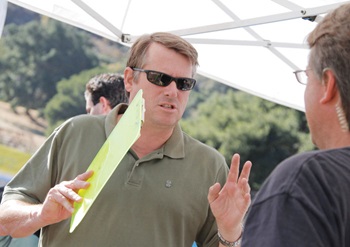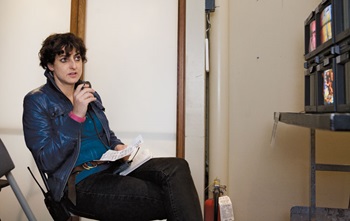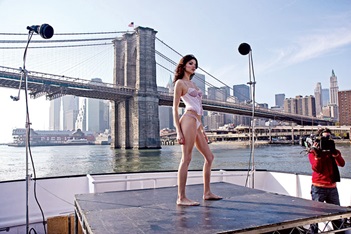By Jeanne Dorin McDowell
During the final season of the reality show Fear Factor in 2006, J. Rupert Thompson directed a stunt that was so big, so logistically challenging, and so expensive it could have come right out of the Michael Bay playbook, which is exactly what Thompson liked about it. In this episode of the show, which pits contestants against one another in dangerous, outrageous, and often downright icky (e.g., people covered with worms) sorts of stunts for a $50,000 prize, a helicopter dropped a two-person team on suspension wires onto the deck of the USS Hornet aircraft carrier, and the contestants had to pluck hand grenades off the top of a moving truck before it drove off the end of the carrier into the ocean. The contestant who clipped the most grenades onto himself won.

For Thompson that stunt signifies what he loves most about his job. “It’s the combination of having to fly by the seat of your pants because you never know what will happen, and being someone who can shoot action and make it feel fast, scary, gross—whatever is needed.”
For directors like Thompson, who has been working on Wipeout since 2008, reality TV is a genre that’s come a long way. When he first started working in reality in the early 1990s as a camera operator on MTV’s The Real World, the genre was in its nascence. It started as a cheap way to fill primetime hours, but it didn’t take long for TV executives to realize that this Band-Aid programming—with its seemingly unrehearsed anything-can-happen appeal—had struck a chord among viewers. As it turned out, audiences had a huge appetite for watching the “private” lives of others, as well as rooting for regular folks who tested their mettle in outrageous action/adventure competitions. With the arrival of Big Brother and Survivor in 2000, the genre exploded.

As reality TV quickly evolved and grew—due to both its popularity and the comparatively low cost of production—the Directors Guild started making inroads on behalf of its members. In 2003, recognizing the need to officially bring reality directors into the fold, then-DGA president Michael Apted formed the Reality Television Committee to address issues of concern to directors working in the new genre and the 2004 contract negotiated extended provisions for reality directors so that members on these shows were ensured fair pay and benefits. The committee successfully launched an intensive campaign to organize reality programming. For the 2004-2005 season, 55 reality shows were Guild signatories. To date, more than 625 shows have been under Guild auspices.
In the early days, some production companies making reality shows were already engaged in agreements with the DGA and so the directors they hired were required to join the Guild. Such was the case with Thompson, who was hired by Dick Clark Productions in 1996 to direct a one-hour reality special, We’re Having a Baby!, about actress Marilu Henner’s pregnancy. “They were Guild and wanted me to direct the show because I had come from The Real World, so that’s how I got into the Guild,” says Thompson.
Recognizing the distinctive and different needs of reality television production, as opposed to more traditional formats, the Guild’s reality television agreements for the networks are made on a show-by-show basis and provide for specific staffing, residual payments, pay rates, and pension and health contributions. For basic cable, all terms and conditions are negotiable except for pension and health contributions.
“By making everything negotiable it allows companies interested in working with Guild directors to work out their own terms that are suitable to both sides,” says Craig Borders, a co-chair of the Guild’s Reality Television Committee. “It opens up more opportunities by not having minimums.”
In addition, when a reality show signs on with the Guild it is guaranteed a level of professional excellence.
“The Guild has the most qualified directors, so the shows that use Guild members typically have better coverage and looks,” says Tony Croll, a director of reality shows such as Average Joe and America’s Next Top Model since 2000 and a member of the Reality Television Committee. “The directors are protected more financially with residuals and with health benefits and a pension, and a better quality of life for all.” And within the filmmaking community, adds Croll, “people are increasingly realizing the skill set we have,” which was not always the case.

The craft of reality TV directing was given a big boost in 2005 when the DGA decided to add the genre to its annual awards. At the time, Apted noted, “Over the past several years, reality television has radically transformed the television landscape…. It is time to publicly acknowledge the director’s role in reality television and to recognize, with a DGA Award, the outstanding directorial achievements of members who work in this genre.” Thompson and Croll shared the first award for episodes of, respectively, Fear Factor and Three Wishes.Thompson is known for intensive camera work, sped-up exterior shots and the use of multiple cameras. In one car stunt for Fear Factor he employed 28 cameras—10 standard cameras run by operators and 18 tiny point-of-view cameras attached to objects to record action where larger cameras wouldn’t fit. “The story only happens once,” he explains. “The more angles I can get of a stunt, the more the editor has to work with, and the more exciting it is for the viewer. I’m always looking for the most exciting way to find that grand epic shot.”
While scripted television requires directors to elicit the best performances from actors, reality is a whole different ballgame, where stunts are staged and cast members (not actors) may (or may not) have loose guidelines and scripts, but the central action and responses are unrehearsed and, ideally, unexpected moments result. That means the director’s primary objective is to make sure he or she is getting the best footage, and plenty of it, giving editors enough to create a narrative.

“Reality is more difficult to direct than scripted,” maintains Claudia Frank, who worked in casting on The Simple Life, expanded her skills on Eco-Challenge and Survivor, and went on to become a segment director for America’s Next Top Model. “You don’t have four weeks of prep to go over the script and figure out your shots. You don’t get your wide angle and close-up or get to say, ‘Do it again.’ You have to get it as it’s happening. You have to make decisions and choices on the spot about what tells the story best. It’s about having a lot of intuition about people and sometimes knowing what they’re going to do before they do it.”
For instance, Frank recalls the mad scramble to get the action on tape shooting on a windy day in Morocco for Top Model. “We were running through a street with 10 cast members and people coming after us, and were trying to get in front of one of the cast members to shoot,” she says. “In reality television we’re interacting with the real world. We’re not in an environment that’s just for us. We have to get what we need without making any impact on what’s going on around us.”

In this environment the relationship between directors and camera operators is intensive, and many reality directors have come up through the ranks as photographers, camera operators, and directors of photography, and sometimes wear both hats (director and DP) on reality shows. “It is a natural transition because often as the DP you and a camera operator are told to go shoot and you have to make decisions on the spot,” explains Croll. Adds Bryan O’Donnell, director of Food Network’s Private Chefs of Beverly Hills, “Many times a reality director has to know how to get out of the way and trust his or her camera operators. Good reality directing comes from good preparation and communicating properly with all the moving parts, and letting everyone know what the goal for the day is. Then I get out of the way and let it happen.”
Today, the reality landscape continues to expand and has become the most ubiquitous genre on television, from the action/adventure competitions (Fear Factor and The Amazing Race) to food and cooking shows (Iron Chef, MasterChef, and Top Chef) and, more recently, grittier, cinéma vérité-type programming such as 16 and Pregnant and Teen Mom. “When I began in reality it was a ragtag bunch of people trying to make stories out of whatever we documented,” says Borders, who recently completed directing Spike TV’s upcoming tattoo competition InkMasters. “Now it’s become a major economic beast, a huge industry. With that growth it has lost that start-up feeling that we’re on the ground floor. It’s more cutthroat, more competitive.”

As the variety of programs within the reality universe continues to spread and add new wrinkles, so too does the skill set required by directors, which is unlike any other genre. It’s no secret that many reality shows—The Hills among them—set up situations ahead of time to chart the course of the story. Despite allegations that “reality” is, well, not so real, directors of the genre maintain that even if the situations are created, the responses and interactions of cast members are authentic and that’s what they’re after. So while most directors seek to develop trust with actors, reality directors often keep interactions with cast members to a minimum. They want feelings, frustrations, and pent-up emotions to be saved for on-camera. “You don’t want cast members using camera operators as a verbal outlet,” explains Frank. “You want them to forget the cameras are even there.”
Reality shows operate differently across the spectrum of the genre. “Typically every show has its own set of rules,” says Croll. “You can have a show that simply captures vérité or a show that has a 100-page script and the same number of scenes as a scripted program even though they’re calling it ‘reality.’ Sometimes it’s a hybrid where you tell people the basics of what you’re looking for. Sometimes we shoot and encourage cast members to talk and let the story develop, and we just follow along.”
Similarly, the role of the director and how he or she works varies. While some are more intent on action aspects, Hisham Abed, who directed MTV’s hit The Hills from 2006 until its final episode in 2010, scouted restaurants and nightclubs in Los Angeles to orchestrate the backdrops where encounters between cast members would take place on the show.
“I tried to direct the cameras and capture what one would assume to be the reality, or as close to true documentary as possible,” says Abed. “For me, the personal challenge was to make our show as cinematic as possible. If possible, I like a show to have a narrative feel as opposed to one interrupted by sound bites and on-camera interviews. I always shot with at least three cameras, sometimes six, and the goal when the action speeded up at a party or in a crowded nightclub was to keep a consistent look.”
Abed convened weekly meetings with cast members to get a sense of what was happening in their lives, which then helped him determine how to approach the action on the show. “We would ask them to bring up things for discussion and encourage them to really express themselves and perhaps accentuate the drama going on in their lives,” says Abed, who worked as DP on The Hills’ predecessor, Laguna Beach, before moving into directing.
Croll, who was nominated for a second DGA Award for Shooting Sizemore in 2007, a six-part VH1 series examining the life of troubled actor Tom Sizemore, says an ongoing challenge in reality television is having enough time and allocating resources properly. “You can have 14-plus cast members and maybe you don’t have enough crew to cover the cameras,” he explains. “Or who you mic can be a huge issue. I usually hire an audio supervisor to work out the best strategy for covering a scene. But you can have 23 people and only 10 mics. We do multitracking so everyone can be isolated individually on a mic, which means juggling all your resources and making the right decisions.”
On Top Model, which has aired since 2003, the job is to capture two distinctly different kinds of action—what happens on the runway and what happens behind the scenes in living quarters—the catfights, meltdowns, and Sturm und Drang of overwrought young models. During his stint directing the show, Thompson attempted to introduce more high-key lighting and drama to the runway scenes, and confesses he went through the lighting budget in the first week of shooting. Frank, who has been a director on the show for five years, oversees action in the house with two cameras rolling almost 24 hours a day under her watchful eye.
“The drama in the house is all reality,” says Frank, who takes notes continuously so she can highlight important footage for editors who then wade through 300 minutes of footage to end up with one minute on the air.
In reality TV, the issue for directors of how much to clue cast members in to what’s happening, or feed them lines, differs from show to show. Many directors give the cast a sense of where they want the narrative to go, while some opt for big surprises that might yield better on-screen drama. On Private Chefs of Beverly Hills, which situates real chefs in the homes of private citizens where they prepare a meal, O’Donnell opted to keep chefs in the dark.
“I would interview the client ahead of time and withhold a few things from the chef so I could get a real reaction,” he says. “We create the bubble that may not be realistic but have the reaction within that faux bubble.
“What I like about directing reality is it’s like a sporting event,” he continues. “You don’t know where the ball is going to bounce, and you’re able to go off the playbook. It can be nerve-racking. I look at a lot of films and television and think they would be easy to direct, and I would love to be able to tell actors how to say their lines. But this is people reacting to a situation in the only way they know how. It’s very unique.